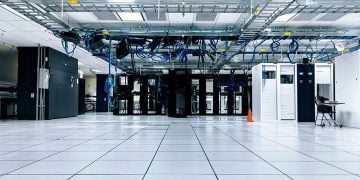Edge computing is revolutionizing the way business operates. This has sparked a massive uptake of edge computing products and services. Research predicts that the edge computing market will exceed $155.9 billion by 2030.
Unlike many other computing technologies, edge computing brings real benefits to businesses. By bringing processing power and data storage closer to users, edge computing enables businesses to improve performance and responsiveness. The result is increased productivity, lower costs, and happier customers.
However, with the advent of a new era of computing, new security risks have come with it. Edge devices are often located in remote and hard-to-protect locations. They are also often connected to critical infrastructure and systems, making them a target for hackers.
In fact, edge computing represents a fundamental shift in the IT paradigm for most enterprises. There is a huge learning curve and countless complexities that can lead to serious security issues if not adequately mitigated.
What is edge security?
Edge security is the protection of data stored or processed at the edge of the network. The edge can be defined in different ways, but generally, it includes any device or location outside the direct control of the enterprise. This may include sensors, IoT-connected devices, and mobile devices.
Data is usually stored in a centralized location, such as a data center or cloud. Whereas in edge computing, data is processed and held closer to where it is collected. This has several advantages, such as reducing latency and increasing reliability and resiliency. However, it also brings new security challenges. These risks include:
- Data loss: As one of the biggest risks associated with edge computing, data loss can occur if a device is lost or stolen, or damaged or damaged.
- Data Breach: Data breaches can occur if devices are not properly secured or hacked.
- Performance issues: Performance issues can arise when there is not enough bandwidth available, or too many devices access the same data.
What’s Driving Edge Security
In a rapidly digitized world, data has become one of the most valuable commodities. As a result, protecting data has become a top priority for businesses of all sizes. Edge security is a type of data security that focuses on protecting the source of data, which is the edge of the network. By preventing data breaches at the edge, businesses can reduce the risk of data breaches and unauthorized access.
Edge security is driven by the need to protect data in transit and at rest. In many cases, data breaches occur during data transmission, making edge security an essential part of data security.
Data integration is another driver of edge security. As more and more data is collected from various sources, it becomes more difficult to keep track of all the data and ensure its security. Edge security can help address this challenge by providing a centralized platform to manage data security. By understanding the drivers of edge security, businesses can develop more effective data security strategies and protect their most valuable assets.
Additionally, mobile and IoT applications are growing exponentially, which means an increased need for platforms that are highly accessible, low latency, performant, secure, and easily scalable. These platforms must also handle the vast amounts of data generated and consumed at the edge.
There are several aspects to consider when implementing an edge security solution. These include:
Protect surrounding facilities
Technical safeguards are critical to perimeter security. These measures include firewalls, intrusion detection systems, encrypted tunnels, and access controls.
Physical safeguards are also necessary, such as protecting areas where edge equipment is located by using physical barriers such as safe rooms, fences and doors, and installing intruder sirens where possible.
The bottom line is that security solutions must be comprehensive and take into account all the different aspects of perimeter security. Otherwise, hackers may exploit vulnerabilities in security systems. Additionally, edge perimeter security solutions must evolve to stay ahead of the latest threats.
Edge applications are another key area to focus on. If they are not adequately protected, they expose businesses to a range of potential threats.
There are many different ways to secure applications, and the right solution will depend on the specific needs of the business. However, standard approaches include encryption, user authentication, application firewalls, code signing and integrity checking, and application programming interface (API) security.
Edge applications are also often built on legacy systems, making them more difficult to secure. Therefore, consideration must also be given to how edge applications interact with legacy systems and what security measures need to be implemented to protect them.
Additionally, regular security testing of edge applications is imperative. This will help identify any vulnerabilities that hackers might exploit.
Manage Vulnerabilities
Cybersecurity teams must manage vulnerabilities throughout the lifecycle of an edge device or system. This includes identifying, assessing, patching and monitoring vulnerabilities.
There must be a comprehensive vulnerability management strategy that covers all aspects of the edge device or system.
One of the most important aspects of keeping an edge network secure is making sure all devices are up to date with the latest security patches. However, installing security patches can be difficult for the following reasons:
● Many edge devices are located in remote or hard-to-reach locations, making it challenging to physically access them to install patches.
● Many edge devices have limited storage space, making it difficult to install large security patches.
● Many edge devices have limited resources and limited computing power, so installing large security patches is a problem.
Therefore, having a patch management strategy that takes into account these challenges is critical. This includes developing a process to identify and install the most critical security patches in a timely manner. A plan must also be in place to deal with unpatched vulnerabilities.
One way to address these challenges is to use automated patch management software. Automated patch management software can help enterprises update edge devices with the latest security patches by automatically downloading and installing patches.
This reduces potential surface attacks and the workload of IT staff, who can focus on core business tasks.
Early threat detection
Because edge computing is distributed and decentralized, providers must have proactive threat detection techniques in place to identify potential vulnerabilities early on. Edge security solutions must be able to detect threats in real-time and send alerts to the appropriate personnel.
Businesses must also develop a plan for how to respond to potential threats. This includes having the appropriate personnel and resources to investigate and mitigate threats.
It is also critical to have an incident response plan that covers all aspects of the edge network. For example, the plan will include identifying the different types of incidents that may occur, the appropriate response to each, and the roles and responsibilities of each team member.
By deploying a comprehensive edge security solution, businesses can help protect their data and systems from potential threats. Edge security solutions must evolve to stay ahead of the latest threats and vulnerabilities. By taking proactive security measures, businesses can help ensure their edge networks are secure and resilient.
Edge Computing and Secure Access Service Edge
Given recent edge networking and security advancements, discussing edge security without mentioning secure access to the service edge is a no-brainer. Secure Access Service Edge is a new architecture first defined by Gartner in 2019 that combines networking and security functions into a single integrated solution.
SASE solutions are designed to address the unique challenges of edge computing, including the need for real-time data processing, low latency, and high bandwidth. Additionally, SASE solutions are designed to provide a consistent security posture across all locations and devices.
SASE solutions are built on many technologies, including software-defined networking (SDN), network functions virtualization (NFV), and cloud security. These technologies work together to provide a unified end-to-end security solution.
SASE solutions have seen widespread adoption, as predicted by Gartner in 2019. They promise to be a way to address the unique challenges of edge computing. As more and more enterprises move to the edge, we expect more SASE solutions to be developed and deployed.
Enterprise Edge Security Tips
Here are edge computing security tips for businesses:
- Edge computing security starts with a proactive and comprehensive security strategy: The strategy should take into account the unique characteristics of edge deployments, such as distributed locations, limited resources, and limited connectivity.
- Access control and monitoring: This is critical to edge security, and enterprises should consider implementing solutions such as biometrics, access control lists, and intrusion detection systems. Additionally, video surveillance can be used to monitor activity at edge locations.
- Control edge configuration and operations from central IT: This helps ensure edge devices are properly configured and only authorized individuals can access them.
- Establish audit procedures: Track changes to edge devices and configurations, which will help quickly identify any unauthorized changes that may have been made.
- Monitor and log all edge activity: Activity should be monitored in real-time to quickly identify any suspicious behavior. Additionally, logs should be checked regularly to identify any patterns or trends.
- Vulnerability management: Organizations should implement regular patch cycles to keep edge devices updated with the latest security patches. Additionally, they should consider using vulnerability scanning tools to identify potential weaknesses.
As more and more businesses move to the edge, it’s important to develop a comprehensive security strategy. Edge computing presents a unique set of challenges, but by following these tips, businesses can reduce risk and reap the benefits of this new technology.



























